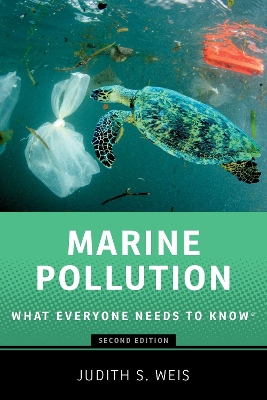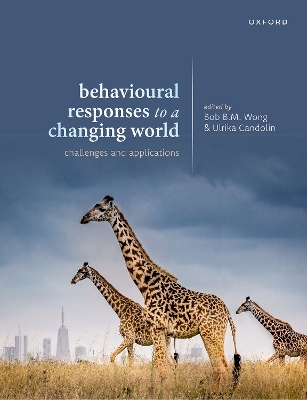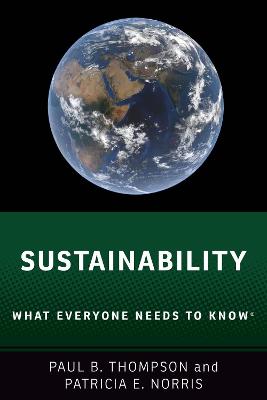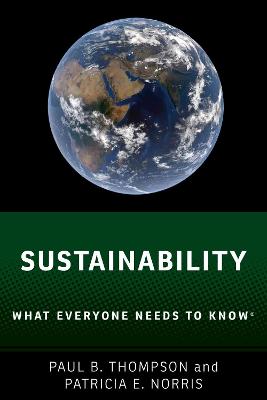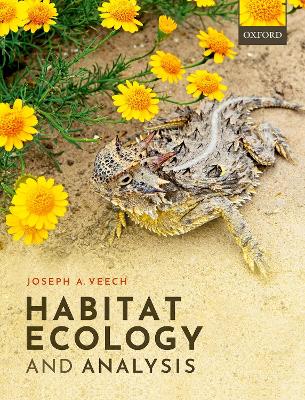Ecology
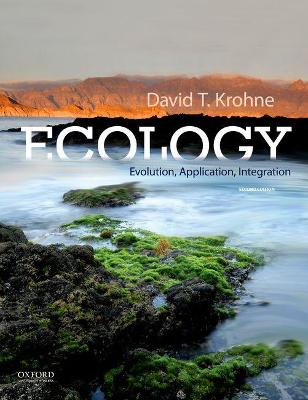 -10%
portes grátis
-10%
portes grátis
Ecology
Evolution, Application, Integration
Krohne, David T.
Oxford University Press Inc
03/2022
576
Mole
Inglês
9780190638887
15 a 20 dias
1242
Descrição não disponível.
Chapter 1: Introduction to Ecology
1.1 What Is Ecology?
1.2 What Important Ideas Will Emerge In Your Study Of Ecology?
Chapter 2: Adaptation and Evolution
2.1 How Did Darwin Develop The Theory of Evolution by Natural Selection?
2.2 What Is Evolution?
2.3 What Are the Mechanisms of Evolution?
2.4 How Do Adaptations Arise?
FEATURES
The Human Impact
The Evolution of Resistance in Pathogens and Pests
On the Frontline
Gene Flow in Gobies
Do the Math
Modeling the Rate of Change by Selection
The Evolution Connection
Phenotypic Plasticity
Chapter 3: Adaptations to the Physical Environment
3.1 How Do Environmental Factors Limit Growth And Survival?
3.2 What Adaptations Avoid Harsh Conditions?
3.3 How Do Physiological Adaptations Alter The Organism's Tolerance Limits?
FEATURES
The Human Impact
Profound Changes to Coral Reefs
On the Frontline
Behavioral Thermoregulation in Lizards
Do the Math
Working with Bell Curves
The Evolution Connection
Plant Adaptations to Life on Land
Chapter 4: Terrestrial Communities
4.1 What Determines Species Distributions?
4.2 What Are The Fundamental Types Of Terrestrial Communities?
FEATURES
Do the Math
The Concept of Statistical Significance
The Evolution Connection
Historical Effects on Species Distributions
The Human Impact
Global Warming and Ecological Communities
On the Frontline
Geographic Range Equilibrium
Chapter 5: Freshwater and Marine Communities
5.1 How is Water Distributed Across the Earth?
5.2 What Kinds of Communities Occur In Freshwater Ecosystems? 5.3 What Kinds of Communities Occur In Marine Ecosystems?
5.4. What are the important Physical and Ecological Factors in Aquatic Systems?
FEATURES
On the Frontline
Recovery from Coral Bleaching .
Do the Math
Linear Regression
The Human Impact
Survival of the Everglades
The Evolution Connection
Not All Characteristics Are Adaptive
Chapter 6: Behavioral Ecology
6.1 How Does Behavior Evolve?
6.2 What Role Does The Ecosystem Play In the Evolution of Behavior?
6.3 How Does The Social System Evolve?
FEATURES
The Evolution Connection
Measuring the Contributions of Environment and Genetics to Behavior
On the Frontline
Balancing Selection and Sexual Selection in an insect
Do the Math
Using Hardy-Weinberg Analysis to Study Inbreeding
The Human Impact
Conservation of Wild Populations
Chapter 7: The Ecology of Intraspecific Variation
7.1 What Are The Patterns of Local Environmental Variation?
7.2 What Are The Adaptive Responses To Local Environmental Variation?
7.3 What Factors Determine The Amount Of Intraspecific Variation?
What Mechanisms Increase Genetic Variation?
What Mechanisms Decrease Variation?
How Do We Measure Genetic Variation In Populations?
FEATURES
On the Frontline
Intraspecific Variation in Coral Reef Fish Swimming Phenotypes
The Evolution Connection
The Evolution of Sex
Do the Math
Measuring Genetic Variation
The Human Impact
Conservation Genetics in Small Populations
Chapter 8: Demography
8.1 What Is a Population?
8.2 What Are The Key Quantitative Characteristics of a Population?
8.3 How Do Populations Change In Time and Space?
FEATURES
The Evolution Connection
The Interaction of Evolution and Population Ecology
On the Frontline
The Human Impact
Human Reproductive Rates
Do the Math
Matrix Algebra
Chapter 9: Population Regulation
9.1 What Limits Population Growth?
9.2 Are Populations Ever Stable?
9.3 How Do Regulatory Factors Interact?
9.4 How Do Populations Interact?
FEATURES
The Human Impact
Biological Control of Pests
Do the Math
Logistic Growth with Dynamic Resources
The Evolution Connection
Group Selection and Evolutionarily Stable Strategies
On the Frontline
Additive vs Compensatory Mortality in Grasshoppers
Chapter 10: Life History Strategies
10.1 What Is A Life History Strategy?
10.2. Why Do Some Species Have Complex Life Cycles?
10.3 What Determines The Lifespan?
10.4 What Determines The Optimal Reproductive Pattern?
FEATURES
The Evolution Connection
Technology and Evolutionary Strategies
Do the Math
The Difference in Production between Semelparity and Interoparity
On the Frontline
Reproductive effort and senescence in birds
The Human Impact
The Effect of Life History on the Risk of Extinction
Chapter 11: Competition
11.1 What Is Competition?
11.2 What Determines The Intensity of Competition?
11.3 What Are The Ecological and Evolutionary Consequences of Competition?
FEATURES
On the Frontline
Character Displacement in Chickadee Songs
The Human Impact
Competition and Invasive Species
The Evolution Connection
The Effect of Competition on Evolutionary History
Do the Math
How to Quantify Niche Overlap
Chapter 12: Coevolution I: Exploitative Interactions
12.1 How Do Predators And Prey Adapt To One Another?
12.2 How Do Plants Respond To Herbivory?
12.3 How Do Parasites And Their Hosts Coevolve?
FEATURES
Do the Math
How Long Should a Predator Remain in a Patch?
On the Frontline
The Evolution Connection
The Phylogenetic Relationship of Parasites and Hosts
The Human Impact
Chapter 13: Coevolution II: Mutualism
13.1 What Are The Fundamental Types of Mutualism?
13.2 How Does Mutualism Arise?
13.1 What Are The Ecological Consequences Of Mutualism
FEATURES
Do The Math
Cheaters and the Prisoners Dilemma
On the Frontline
Ants Disrupt Bublebee-Flower Pollination Mutualism
The Evolution Connection
What Is The Evolutionary History of Mutualism?
The Human Impact
Mutualism And Species Conservation
Chapter 14: The Structure of Communities
14.1 What Processes Determine Community Composition?
13.2 How Does Competition Structure the Community?
13.3 What Other Ecological Factors Structure the Community?
FEATURES
Do the Math
The Null Hypothesis in Community Structure
The Human Impact
Competition from Invasive Species
The Evolution Connection
Community Heritability and Structure
On the Frontline
The Determinants of Local Tropical Forest Species Diversity
Chapter 15: Ecological Succession
15.1 What Are The Effects of Disturbance?
15. 2 What Are The Patterns of Vegetation Change Following Disturbance?
15.3 What Causes Successional Change?
15.4 What Role Do Consumers Play in Succession?
FEATURES
On the Frontline
Facilitation in aspen-conifer forests
Do the Math
Markov Chains
The Human Impact
Succession and Conservation Biology
The Evolution Connection
Pioneer Species
Chapter 16: Species Diversity
16.1 How Do We Measure Species Diversity?
16.2 How Do Communities Vary in Species diversity?
16.3 Why Do Communities Differ In Species Diversity?
FEATURES
On the Frontline
The Human Impact
The Sixth Mass Extinction
Do the Math
The Equilibrium Number of Species on an Island
The Evolution Connection
How Species Arise
Chapter 17: Energy Flow and Trophic Structure
17.1 What Are The Energy Sources in Ecosystems?
17.2 What Limits Primary Production?
17.3 What Controls Energy Flow through Consumers?
17.4 How Does Energy Flow Structure Ecosystems?
FEATURES
The Human Impact
Biomagnification
The Evolution Connection
The Evolution of C4 Photosynthesis
Do the Math
Allometry
On the Frontline
Production and Food Chain Length
Chapter 18: Biogeochemical Cycles
18.1 What Are The Important Mechanisms Of Nutrient Cycling?
18.2 What Are The Major Types Of Nutrient Cycles?
18.3 What Is The Role Of Disturbance?
FEATURES
Do the Math
Variance and Ecosystem Models
The Evolution Connection
Oxygen and the Origin of Complex Life Forms
The Human Impact
Soil Fertility and Nutrient Cycles
On the Frontline
The Response of the Forest Nitrogen Cycle to Disturbance
Chapter 19: Conservation Biology
19.1 What Are The Global Patterns of Species Richness And Extinction?
19.2 What Processes Lead To Extinction?
19.3 How Can We Prevent Extinction?
FEATURES
The Evolution Connection
Evolution of the Population Growth Rate
On the Frontline
Extinction Debt in a Mediterranean Shrub
Do the Math
Maximum Sustainable Yield
The Human Impact
The Value of Biodiversity
Chapter 20: Landscape Ecology
20.1 What Is An Ecological Landscape?
20.2 How Do We Quantify Landscape Patterns?
20.3 What Are The Effects Of Landscape Scale and Structure?
FEATURES
The Human Impact
Recovery of the Black-Footed Ferret
The Evolution Connection
Landscape Genetics
Do the Math
Fractal Geometry
On the Frontline
Agricultural disturbance and tropical forest regeneration
Chapter 21: Human Global Ecology
21.1 What Is The History Of The Human Environmental Impact?
21.2 How Does Human Activity Threaten The Environment?
21.3 What Ecological Principles Can We Apply To Environmental Problems?
FEATURES
Do the Math
The Binomial Probability
The Evolution Connection
Genetically Modified Organisms
On the Frontline
Plant extinction: Habitat loss or climate change?
The Human Impact
The Relationship of Humans to the Natural World
1.1 What Is Ecology?
1.2 What Important Ideas Will Emerge In Your Study Of Ecology?
Chapter 2: Adaptation and Evolution
2.1 How Did Darwin Develop The Theory of Evolution by Natural Selection?
2.2 What Is Evolution?
2.3 What Are the Mechanisms of Evolution?
2.4 How Do Adaptations Arise?
FEATURES
The Human Impact
The Evolution of Resistance in Pathogens and Pests
On the Frontline
Gene Flow in Gobies
Do the Math
Modeling the Rate of Change by Selection
The Evolution Connection
Phenotypic Plasticity
Chapter 3: Adaptations to the Physical Environment
3.1 How Do Environmental Factors Limit Growth And Survival?
3.2 What Adaptations Avoid Harsh Conditions?
3.3 How Do Physiological Adaptations Alter The Organism's Tolerance Limits?
FEATURES
The Human Impact
Profound Changes to Coral Reefs
On the Frontline
Behavioral Thermoregulation in Lizards
Do the Math
Working with Bell Curves
The Evolution Connection
Plant Adaptations to Life on Land
Chapter 4: Terrestrial Communities
4.1 What Determines Species Distributions?
4.2 What Are The Fundamental Types Of Terrestrial Communities?
FEATURES
Do the Math
The Concept of Statistical Significance
The Evolution Connection
Historical Effects on Species Distributions
The Human Impact
Global Warming and Ecological Communities
On the Frontline
Geographic Range Equilibrium
Chapter 5: Freshwater and Marine Communities
5.1 How is Water Distributed Across the Earth?
5.2 What Kinds of Communities Occur In Freshwater Ecosystems? 5.3 What Kinds of Communities Occur In Marine Ecosystems?
5.4. What are the important Physical and Ecological Factors in Aquatic Systems?
FEATURES
On the Frontline
Recovery from Coral Bleaching .
Do the Math
Linear Regression
The Human Impact
Survival of the Everglades
The Evolution Connection
Not All Characteristics Are Adaptive
Chapter 6: Behavioral Ecology
6.1 How Does Behavior Evolve?
6.2 What Role Does The Ecosystem Play In the Evolution of Behavior?
6.3 How Does The Social System Evolve?
FEATURES
The Evolution Connection
Measuring the Contributions of Environment and Genetics to Behavior
On the Frontline
Balancing Selection and Sexual Selection in an insect
Do the Math
Using Hardy-Weinberg Analysis to Study Inbreeding
The Human Impact
Conservation of Wild Populations
Chapter 7: The Ecology of Intraspecific Variation
7.1 What Are The Patterns of Local Environmental Variation?
7.2 What Are The Adaptive Responses To Local Environmental Variation?
7.3 What Factors Determine The Amount Of Intraspecific Variation?
What Mechanisms Increase Genetic Variation?
What Mechanisms Decrease Variation?
How Do We Measure Genetic Variation In Populations?
FEATURES
On the Frontline
Intraspecific Variation in Coral Reef Fish Swimming Phenotypes
The Evolution Connection
The Evolution of Sex
Do the Math
Measuring Genetic Variation
The Human Impact
Conservation Genetics in Small Populations
Chapter 8: Demography
8.1 What Is a Population?
8.2 What Are The Key Quantitative Characteristics of a Population?
8.3 How Do Populations Change In Time and Space?
FEATURES
The Evolution Connection
The Interaction of Evolution and Population Ecology
On the Frontline
The Human Impact
Human Reproductive Rates
Do the Math
Matrix Algebra
Chapter 9: Population Regulation
9.1 What Limits Population Growth?
9.2 Are Populations Ever Stable?
9.3 How Do Regulatory Factors Interact?
9.4 How Do Populations Interact?
FEATURES
The Human Impact
Biological Control of Pests
Do the Math
Logistic Growth with Dynamic Resources
The Evolution Connection
Group Selection and Evolutionarily Stable Strategies
On the Frontline
Additive vs Compensatory Mortality in Grasshoppers
Chapter 10: Life History Strategies
10.1 What Is A Life History Strategy?
10.2. Why Do Some Species Have Complex Life Cycles?
10.3 What Determines The Lifespan?
10.4 What Determines The Optimal Reproductive Pattern?
FEATURES
The Evolution Connection
Technology and Evolutionary Strategies
Do the Math
The Difference in Production between Semelparity and Interoparity
On the Frontline
Reproductive effort and senescence in birds
The Human Impact
The Effect of Life History on the Risk of Extinction
Chapter 11: Competition
11.1 What Is Competition?
11.2 What Determines The Intensity of Competition?
11.3 What Are The Ecological and Evolutionary Consequences of Competition?
FEATURES
On the Frontline
Character Displacement in Chickadee Songs
The Human Impact
Competition and Invasive Species
The Evolution Connection
The Effect of Competition on Evolutionary History
Do the Math
How to Quantify Niche Overlap
Chapter 12: Coevolution I: Exploitative Interactions
12.1 How Do Predators And Prey Adapt To One Another?
12.2 How Do Plants Respond To Herbivory?
12.3 How Do Parasites And Their Hosts Coevolve?
FEATURES
Do the Math
How Long Should a Predator Remain in a Patch?
On the Frontline
The Evolution Connection
The Phylogenetic Relationship of Parasites and Hosts
The Human Impact
Chapter 13: Coevolution II: Mutualism
13.1 What Are The Fundamental Types of Mutualism?
13.2 How Does Mutualism Arise?
13.1 What Are The Ecological Consequences Of Mutualism
FEATURES
Do The Math
Cheaters and the Prisoners Dilemma
On the Frontline
Ants Disrupt Bublebee-Flower Pollination Mutualism
The Evolution Connection
What Is The Evolutionary History of Mutualism?
The Human Impact
Mutualism And Species Conservation
Chapter 14: The Structure of Communities
14.1 What Processes Determine Community Composition?
13.2 How Does Competition Structure the Community?
13.3 What Other Ecological Factors Structure the Community?
FEATURES
Do the Math
The Null Hypothesis in Community Structure
The Human Impact
Competition from Invasive Species
The Evolution Connection
Community Heritability and Structure
On the Frontline
The Determinants of Local Tropical Forest Species Diversity
Chapter 15: Ecological Succession
15.1 What Are The Effects of Disturbance?
15. 2 What Are The Patterns of Vegetation Change Following Disturbance?
15.3 What Causes Successional Change?
15.4 What Role Do Consumers Play in Succession?
FEATURES
On the Frontline
Facilitation in aspen-conifer forests
Do the Math
Markov Chains
The Human Impact
Succession and Conservation Biology
The Evolution Connection
Pioneer Species
Chapter 16: Species Diversity
16.1 How Do We Measure Species Diversity?
16.2 How Do Communities Vary in Species diversity?
16.3 Why Do Communities Differ In Species Diversity?
FEATURES
On the Frontline
The Human Impact
The Sixth Mass Extinction
Do the Math
The Equilibrium Number of Species on an Island
The Evolution Connection
How Species Arise
Chapter 17: Energy Flow and Trophic Structure
17.1 What Are The Energy Sources in Ecosystems?
17.2 What Limits Primary Production?
17.3 What Controls Energy Flow through Consumers?
17.4 How Does Energy Flow Structure Ecosystems?
FEATURES
The Human Impact
Biomagnification
The Evolution Connection
The Evolution of C4 Photosynthesis
Do the Math
Allometry
On the Frontline
Production and Food Chain Length
Chapter 18: Biogeochemical Cycles
18.1 What Are The Important Mechanisms Of Nutrient Cycling?
18.2 What Are The Major Types Of Nutrient Cycles?
18.3 What Is The Role Of Disturbance?
FEATURES
Do the Math
Variance and Ecosystem Models
The Evolution Connection
Oxygen and the Origin of Complex Life Forms
The Human Impact
Soil Fertility and Nutrient Cycles
On the Frontline
The Response of the Forest Nitrogen Cycle to Disturbance
Chapter 19: Conservation Biology
19.1 What Are The Global Patterns of Species Richness And Extinction?
19.2 What Processes Lead To Extinction?
19.3 How Can We Prevent Extinction?
FEATURES
The Evolution Connection
Evolution of the Population Growth Rate
On the Frontline
Extinction Debt in a Mediterranean Shrub
Do the Math
Maximum Sustainable Yield
The Human Impact
The Value of Biodiversity
Chapter 20: Landscape Ecology
20.1 What Is An Ecological Landscape?
20.2 How Do We Quantify Landscape Patterns?
20.3 What Are The Effects Of Landscape Scale and Structure?
FEATURES
The Human Impact
Recovery of the Black-Footed Ferret
The Evolution Connection
Landscape Genetics
Do the Math
Fractal Geometry
On the Frontline
Agricultural disturbance and tropical forest regeneration
Chapter 21: Human Global Ecology
21.1 What Is The History Of The Human Environmental Impact?
21.2 How Does Human Activity Threaten The Environment?
21.3 What Ecological Principles Can We Apply To Environmental Problems?
FEATURES
Do the Math
The Binomial Probability
The Evolution Connection
Genetically Modified Organisms
On the Frontline
Plant extinction: Habitat loss or climate change?
The Human Impact
The Relationship of Humans to the Natural World
Este título pertence ao(s) assunto(s) indicados(s). Para ver outros títulos clique no assunto desejado.
Chapter 1: Introduction to Ecology
1.1 What Is Ecology?
1.2 What Important Ideas Will Emerge In Your Study Of Ecology?
Chapter 2: Adaptation and Evolution
2.1 How Did Darwin Develop The Theory of Evolution by Natural Selection?
2.2 What Is Evolution?
2.3 What Are the Mechanisms of Evolution?
2.4 How Do Adaptations Arise?
FEATURES
The Human Impact
The Evolution of Resistance in Pathogens and Pests
On the Frontline
Gene Flow in Gobies
Do the Math
Modeling the Rate of Change by Selection
The Evolution Connection
Phenotypic Plasticity
Chapter 3: Adaptations to the Physical Environment
3.1 How Do Environmental Factors Limit Growth And Survival?
3.2 What Adaptations Avoid Harsh Conditions?
3.3 How Do Physiological Adaptations Alter The Organism's Tolerance Limits?
FEATURES
The Human Impact
Profound Changes to Coral Reefs
On the Frontline
Behavioral Thermoregulation in Lizards
Do the Math
Working with Bell Curves
The Evolution Connection
Plant Adaptations to Life on Land
Chapter 4: Terrestrial Communities
4.1 What Determines Species Distributions?
4.2 What Are The Fundamental Types Of Terrestrial Communities?
FEATURES
Do the Math
The Concept of Statistical Significance
The Evolution Connection
Historical Effects on Species Distributions
The Human Impact
Global Warming and Ecological Communities
On the Frontline
Geographic Range Equilibrium
Chapter 5: Freshwater and Marine Communities
5.1 How is Water Distributed Across the Earth?
5.2 What Kinds of Communities Occur In Freshwater Ecosystems? 5.3 What Kinds of Communities Occur In Marine Ecosystems?
5.4. What are the important Physical and Ecological Factors in Aquatic Systems?
FEATURES
On the Frontline
Recovery from Coral Bleaching .
Do the Math
Linear Regression
The Human Impact
Survival of the Everglades
The Evolution Connection
Not All Characteristics Are Adaptive
Chapter 6: Behavioral Ecology
6.1 How Does Behavior Evolve?
6.2 What Role Does The Ecosystem Play In the Evolution of Behavior?
6.3 How Does The Social System Evolve?
FEATURES
The Evolution Connection
Measuring the Contributions of Environment and Genetics to Behavior
On the Frontline
Balancing Selection and Sexual Selection in an insect
Do the Math
Using Hardy-Weinberg Analysis to Study Inbreeding
The Human Impact
Conservation of Wild Populations
Chapter 7: The Ecology of Intraspecific Variation
7.1 What Are The Patterns of Local Environmental Variation?
7.2 What Are The Adaptive Responses To Local Environmental Variation?
7.3 What Factors Determine The Amount Of Intraspecific Variation?
What Mechanisms Increase Genetic Variation?
What Mechanisms Decrease Variation?
How Do We Measure Genetic Variation In Populations?
FEATURES
On the Frontline
Intraspecific Variation in Coral Reef Fish Swimming Phenotypes
The Evolution Connection
The Evolution of Sex
Do the Math
Measuring Genetic Variation
The Human Impact
Conservation Genetics in Small Populations
Chapter 8: Demography
8.1 What Is a Population?
8.2 What Are The Key Quantitative Characteristics of a Population?
8.3 How Do Populations Change In Time and Space?
FEATURES
The Evolution Connection
The Interaction of Evolution and Population Ecology
On the Frontline
The Human Impact
Human Reproductive Rates
Do the Math
Matrix Algebra
Chapter 9: Population Regulation
9.1 What Limits Population Growth?
9.2 Are Populations Ever Stable?
9.3 How Do Regulatory Factors Interact?
9.4 How Do Populations Interact?
FEATURES
The Human Impact
Biological Control of Pests
Do the Math
Logistic Growth with Dynamic Resources
The Evolution Connection
Group Selection and Evolutionarily Stable Strategies
On the Frontline
Additive vs Compensatory Mortality in Grasshoppers
Chapter 10: Life History Strategies
10.1 What Is A Life History Strategy?
10.2. Why Do Some Species Have Complex Life Cycles?
10.3 What Determines The Lifespan?
10.4 What Determines The Optimal Reproductive Pattern?
FEATURES
The Evolution Connection
Technology and Evolutionary Strategies
Do the Math
The Difference in Production between Semelparity and Interoparity
On the Frontline
Reproductive effort and senescence in birds
The Human Impact
The Effect of Life History on the Risk of Extinction
Chapter 11: Competition
11.1 What Is Competition?
11.2 What Determines The Intensity of Competition?
11.3 What Are The Ecological and Evolutionary Consequences of Competition?
FEATURES
On the Frontline
Character Displacement in Chickadee Songs
The Human Impact
Competition and Invasive Species
The Evolution Connection
The Effect of Competition on Evolutionary History
Do the Math
How to Quantify Niche Overlap
Chapter 12: Coevolution I: Exploitative Interactions
12.1 How Do Predators And Prey Adapt To One Another?
12.2 How Do Plants Respond To Herbivory?
12.3 How Do Parasites And Their Hosts Coevolve?
FEATURES
Do the Math
How Long Should a Predator Remain in a Patch?
On the Frontline
The Evolution Connection
The Phylogenetic Relationship of Parasites and Hosts
The Human Impact
Chapter 13: Coevolution II: Mutualism
13.1 What Are The Fundamental Types of Mutualism?
13.2 How Does Mutualism Arise?
13.1 What Are The Ecological Consequences Of Mutualism
FEATURES
Do The Math
Cheaters and the Prisoners Dilemma
On the Frontline
Ants Disrupt Bublebee-Flower Pollination Mutualism
The Evolution Connection
What Is The Evolutionary History of Mutualism?
The Human Impact
Mutualism And Species Conservation
Chapter 14: The Structure of Communities
14.1 What Processes Determine Community Composition?
13.2 How Does Competition Structure the Community?
13.3 What Other Ecological Factors Structure the Community?
FEATURES
Do the Math
The Null Hypothesis in Community Structure
The Human Impact
Competition from Invasive Species
The Evolution Connection
Community Heritability and Structure
On the Frontline
The Determinants of Local Tropical Forest Species Diversity
Chapter 15: Ecological Succession
15.1 What Are The Effects of Disturbance?
15. 2 What Are The Patterns of Vegetation Change Following Disturbance?
15.3 What Causes Successional Change?
15.4 What Role Do Consumers Play in Succession?
FEATURES
On the Frontline
Facilitation in aspen-conifer forests
Do the Math
Markov Chains
The Human Impact
Succession and Conservation Biology
The Evolution Connection
Pioneer Species
Chapter 16: Species Diversity
16.1 How Do We Measure Species Diversity?
16.2 How Do Communities Vary in Species diversity?
16.3 Why Do Communities Differ In Species Diversity?
FEATURES
On the Frontline
The Human Impact
The Sixth Mass Extinction
Do the Math
The Equilibrium Number of Species on an Island
The Evolution Connection
How Species Arise
Chapter 17: Energy Flow and Trophic Structure
17.1 What Are The Energy Sources in Ecosystems?
17.2 What Limits Primary Production?
17.3 What Controls Energy Flow through Consumers?
17.4 How Does Energy Flow Structure Ecosystems?
FEATURES
The Human Impact
Biomagnification
The Evolution Connection
The Evolution of C4 Photosynthesis
Do the Math
Allometry
On the Frontline
Production and Food Chain Length
Chapter 18: Biogeochemical Cycles
18.1 What Are The Important Mechanisms Of Nutrient Cycling?
18.2 What Are The Major Types Of Nutrient Cycles?
18.3 What Is The Role Of Disturbance?
FEATURES
Do the Math
Variance and Ecosystem Models
The Evolution Connection
Oxygen and the Origin of Complex Life Forms
The Human Impact
Soil Fertility and Nutrient Cycles
On the Frontline
The Response of the Forest Nitrogen Cycle to Disturbance
Chapter 19: Conservation Biology
19.1 What Are The Global Patterns of Species Richness And Extinction?
19.2 What Processes Lead To Extinction?
19.3 How Can We Prevent Extinction?
FEATURES
The Evolution Connection
Evolution of the Population Growth Rate
On the Frontline
Extinction Debt in a Mediterranean Shrub
Do the Math
Maximum Sustainable Yield
The Human Impact
The Value of Biodiversity
Chapter 20: Landscape Ecology
20.1 What Is An Ecological Landscape?
20.2 How Do We Quantify Landscape Patterns?
20.3 What Are The Effects Of Landscape Scale and Structure?
FEATURES
The Human Impact
Recovery of the Black-Footed Ferret
The Evolution Connection
Landscape Genetics
Do the Math
Fractal Geometry
On the Frontline
Agricultural disturbance and tropical forest regeneration
Chapter 21: Human Global Ecology
21.1 What Is The History Of The Human Environmental Impact?
21.2 How Does Human Activity Threaten The Environment?
21.3 What Ecological Principles Can We Apply To Environmental Problems?
FEATURES
Do the Math
The Binomial Probability
The Evolution Connection
Genetically Modified Organisms
On the Frontline
Plant extinction: Habitat loss or climate change?
The Human Impact
The Relationship of Humans to the Natural World
1.1 What Is Ecology?
1.2 What Important Ideas Will Emerge In Your Study Of Ecology?
Chapter 2: Adaptation and Evolution
2.1 How Did Darwin Develop The Theory of Evolution by Natural Selection?
2.2 What Is Evolution?
2.3 What Are the Mechanisms of Evolution?
2.4 How Do Adaptations Arise?
FEATURES
The Human Impact
The Evolution of Resistance in Pathogens and Pests
On the Frontline
Gene Flow in Gobies
Do the Math
Modeling the Rate of Change by Selection
The Evolution Connection
Phenotypic Plasticity
Chapter 3: Adaptations to the Physical Environment
3.1 How Do Environmental Factors Limit Growth And Survival?
3.2 What Adaptations Avoid Harsh Conditions?
3.3 How Do Physiological Adaptations Alter The Organism's Tolerance Limits?
FEATURES
The Human Impact
Profound Changes to Coral Reefs
On the Frontline
Behavioral Thermoregulation in Lizards
Do the Math
Working with Bell Curves
The Evolution Connection
Plant Adaptations to Life on Land
Chapter 4: Terrestrial Communities
4.1 What Determines Species Distributions?
4.2 What Are The Fundamental Types Of Terrestrial Communities?
FEATURES
Do the Math
The Concept of Statistical Significance
The Evolution Connection
Historical Effects on Species Distributions
The Human Impact
Global Warming and Ecological Communities
On the Frontline
Geographic Range Equilibrium
Chapter 5: Freshwater and Marine Communities
5.1 How is Water Distributed Across the Earth?
5.2 What Kinds of Communities Occur In Freshwater Ecosystems? 5.3 What Kinds of Communities Occur In Marine Ecosystems?
5.4. What are the important Physical and Ecological Factors in Aquatic Systems?
FEATURES
On the Frontline
Recovery from Coral Bleaching .
Do the Math
Linear Regression
The Human Impact
Survival of the Everglades
The Evolution Connection
Not All Characteristics Are Adaptive
Chapter 6: Behavioral Ecology
6.1 How Does Behavior Evolve?
6.2 What Role Does The Ecosystem Play In the Evolution of Behavior?
6.3 How Does The Social System Evolve?
FEATURES
The Evolution Connection
Measuring the Contributions of Environment and Genetics to Behavior
On the Frontline
Balancing Selection and Sexual Selection in an insect
Do the Math
Using Hardy-Weinberg Analysis to Study Inbreeding
The Human Impact
Conservation of Wild Populations
Chapter 7: The Ecology of Intraspecific Variation
7.1 What Are The Patterns of Local Environmental Variation?
7.2 What Are The Adaptive Responses To Local Environmental Variation?
7.3 What Factors Determine The Amount Of Intraspecific Variation?
What Mechanisms Increase Genetic Variation?
What Mechanisms Decrease Variation?
How Do We Measure Genetic Variation In Populations?
FEATURES
On the Frontline
Intraspecific Variation in Coral Reef Fish Swimming Phenotypes
The Evolution Connection
The Evolution of Sex
Do the Math
Measuring Genetic Variation
The Human Impact
Conservation Genetics in Small Populations
Chapter 8: Demography
8.1 What Is a Population?
8.2 What Are The Key Quantitative Characteristics of a Population?
8.3 How Do Populations Change In Time and Space?
FEATURES
The Evolution Connection
The Interaction of Evolution and Population Ecology
On the Frontline
The Human Impact
Human Reproductive Rates
Do the Math
Matrix Algebra
Chapter 9: Population Regulation
9.1 What Limits Population Growth?
9.2 Are Populations Ever Stable?
9.3 How Do Regulatory Factors Interact?
9.4 How Do Populations Interact?
FEATURES
The Human Impact
Biological Control of Pests
Do the Math
Logistic Growth with Dynamic Resources
The Evolution Connection
Group Selection and Evolutionarily Stable Strategies
On the Frontline
Additive vs Compensatory Mortality in Grasshoppers
Chapter 10: Life History Strategies
10.1 What Is A Life History Strategy?
10.2. Why Do Some Species Have Complex Life Cycles?
10.3 What Determines The Lifespan?
10.4 What Determines The Optimal Reproductive Pattern?
FEATURES
The Evolution Connection
Technology and Evolutionary Strategies
Do the Math
The Difference in Production between Semelparity and Interoparity
On the Frontline
Reproductive effort and senescence in birds
The Human Impact
The Effect of Life History on the Risk of Extinction
Chapter 11: Competition
11.1 What Is Competition?
11.2 What Determines The Intensity of Competition?
11.3 What Are The Ecological and Evolutionary Consequences of Competition?
FEATURES
On the Frontline
Character Displacement in Chickadee Songs
The Human Impact
Competition and Invasive Species
The Evolution Connection
The Effect of Competition on Evolutionary History
Do the Math
How to Quantify Niche Overlap
Chapter 12: Coevolution I: Exploitative Interactions
12.1 How Do Predators And Prey Adapt To One Another?
12.2 How Do Plants Respond To Herbivory?
12.3 How Do Parasites And Their Hosts Coevolve?
FEATURES
Do the Math
How Long Should a Predator Remain in a Patch?
On the Frontline
The Evolution Connection
The Phylogenetic Relationship of Parasites and Hosts
The Human Impact
Chapter 13: Coevolution II: Mutualism
13.1 What Are The Fundamental Types of Mutualism?
13.2 How Does Mutualism Arise?
13.1 What Are The Ecological Consequences Of Mutualism
FEATURES
Do The Math
Cheaters and the Prisoners Dilemma
On the Frontline
Ants Disrupt Bublebee-Flower Pollination Mutualism
The Evolution Connection
What Is The Evolutionary History of Mutualism?
The Human Impact
Mutualism And Species Conservation
Chapter 14: The Structure of Communities
14.1 What Processes Determine Community Composition?
13.2 How Does Competition Structure the Community?
13.3 What Other Ecological Factors Structure the Community?
FEATURES
Do the Math
The Null Hypothesis in Community Structure
The Human Impact
Competition from Invasive Species
The Evolution Connection
Community Heritability and Structure
On the Frontline
The Determinants of Local Tropical Forest Species Diversity
Chapter 15: Ecological Succession
15.1 What Are The Effects of Disturbance?
15. 2 What Are The Patterns of Vegetation Change Following Disturbance?
15.3 What Causes Successional Change?
15.4 What Role Do Consumers Play in Succession?
FEATURES
On the Frontline
Facilitation in aspen-conifer forests
Do the Math
Markov Chains
The Human Impact
Succession and Conservation Biology
The Evolution Connection
Pioneer Species
Chapter 16: Species Diversity
16.1 How Do We Measure Species Diversity?
16.2 How Do Communities Vary in Species diversity?
16.3 Why Do Communities Differ In Species Diversity?
FEATURES
On the Frontline
The Human Impact
The Sixth Mass Extinction
Do the Math
The Equilibrium Number of Species on an Island
The Evolution Connection
How Species Arise
Chapter 17: Energy Flow and Trophic Structure
17.1 What Are The Energy Sources in Ecosystems?
17.2 What Limits Primary Production?
17.3 What Controls Energy Flow through Consumers?
17.4 How Does Energy Flow Structure Ecosystems?
FEATURES
The Human Impact
Biomagnification
The Evolution Connection
The Evolution of C4 Photosynthesis
Do the Math
Allometry
On the Frontline
Production and Food Chain Length
Chapter 18: Biogeochemical Cycles
18.1 What Are The Important Mechanisms Of Nutrient Cycling?
18.2 What Are The Major Types Of Nutrient Cycles?
18.3 What Is The Role Of Disturbance?
FEATURES
Do the Math
Variance and Ecosystem Models
The Evolution Connection
Oxygen and the Origin of Complex Life Forms
The Human Impact
Soil Fertility and Nutrient Cycles
On the Frontline
The Response of the Forest Nitrogen Cycle to Disturbance
Chapter 19: Conservation Biology
19.1 What Are The Global Patterns of Species Richness And Extinction?
19.2 What Processes Lead To Extinction?
19.3 How Can We Prevent Extinction?
FEATURES
The Evolution Connection
Evolution of the Population Growth Rate
On the Frontline
Extinction Debt in a Mediterranean Shrub
Do the Math
Maximum Sustainable Yield
The Human Impact
The Value of Biodiversity
Chapter 20: Landscape Ecology
20.1 What Is An Ecological Landscape?
20.2 How Do We Quantify Landscape Patterns?
20.3 What Are The Effects Of Landscape Scale and Structure?
FEATURES
The Human Impact
Recovery of the Black-Footed Ferret
The Evolution Connection
Landscape Genetics
Do the Math
Fractal Geometry
On the Frontline
Agricultural disturbance and tropical forest regeneration
Chapter 21: Human Global Ecology
21.1 What Is The History Of The Human Environmental Impact?
21.2 How Does Human Activity Threaten The Environment?
21.3 What Ecological Principles Can We Apply To Environmental Problems?
FEATURES
Do the Math
The Binomial Probability
The Evolution Connection
Genetically Modified Organisms
On the Frontline
Plant extinction: Habitat loss or climate change?
The Human Impact
The Relationship of Humans to the Natural World
Este título pertence ao(s) assunto(s) indicados(s). Para ver outros títulos clique no assunto desejado.

